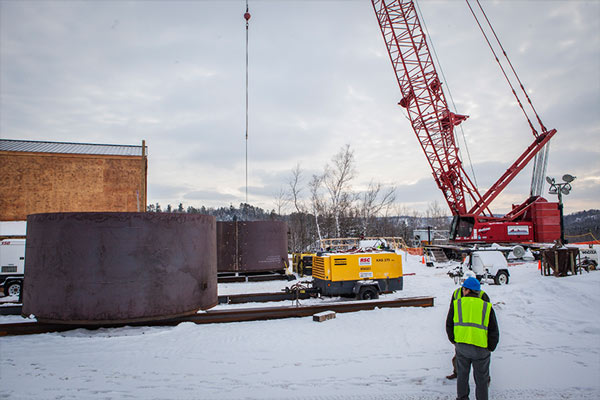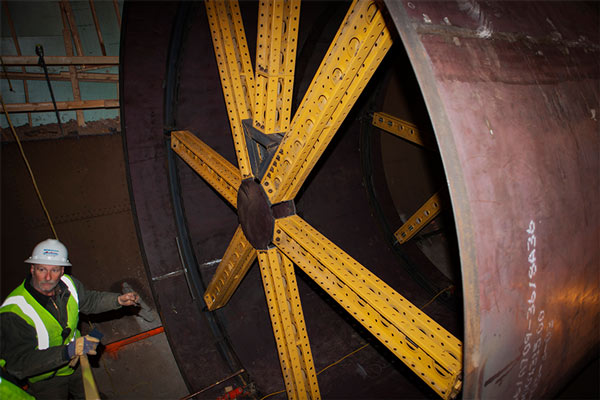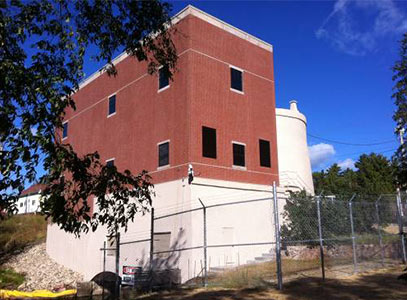
Reliable year after year
You could say that Minnesota Power is in it for the long haul when it comes to hydroelectricity.
Three of our 11 hydro stations—on three different rivers—have marked 100 years of service: Little Falls, on the Mississippi River in Morrison County, Minn., celebrated its centennial in 2006; Thomson, on the St. Louis River in Carlton County, celebrated its centennial in 2007; and Sylvan, on the Crow Wing River about 11 miles west of Brainerd, Minn., followed six years later in 2013.
Pillager, also on the Crow Wing River in Morrison County, Minn., is next in line to reach 100 years of operation. It will mark its centennial in 2017. Nearly all of our 11 hydro stations have been generating renewable electricity for at least 90 years. The equipment and infrastructure at our hydro facilities are designed and maintained to be in service for a long time.
In fact, many times the equipment is so durable it outlasts the people who operate it and are responsible for the routine maintenance. When it comes time to do major upgrades, it can be a little like opening a time capsule because those doing the work have never seen the equipment taken apart before.
Over the decades, maintenance and modernization projects have included generator rewinds, turbine replacement, gate replacement and refurbishment on dams, equipment automation, and many other projects. From routine maintenance to major modernization, the ongoing investments in our hydroelectric system are part of how we’re moving toward a cleaner, more balanced energy future.
Several of our hydroelectric facilities underwent significant upgrades in recent years, including Fond du Lac, Thomson and Prairie River hydro stations, and the dam at Birch Lake Reservoir.
Turbine upgrade, penstock re-lining anchor refurbishment
 Work on the Fond du Lac penstock slip-liner progressed throughout the winter of 2012-13. Two steel sections, each about 16½ feet in diameter, are welded together before a crane (right) places them into the penstock where a system of rails and winches positions them.
Work on the Fond du Lac penstock slip-liner progressed throughout the winter of 2012-13. Two steel sections, each about 16½ feet in diameter, are welded together before a crane (right) places them into the penstock where a system of rails and winches positions them.
 Pinwheel-like braces, sometimes called “super studs,” help adjust and maintain the shape of the slip-liner as sections are positioned in place inside the original penstock. The super studs are removed after the sections are welded in place.
Pinwheel-like braces, sometimes called “super studs,” help adjust and maintain the shape of the slip-liner as sections are positioned in place inside the original penstock. The super studs are removed after the sections are welded in place.
A new, more efficient turbine was the centerpiece of a major refurbishment at Fond du Lac Hydro Station. An $800,000 grant from the U.S. Department of Energy, part of the American Recovery and Reinvestment Act, went toward the replacement of the original turbine with a state-of-the-art steel runner. The remainder of the $8 million project included rewinding the generator, slip-lining the penstock and other modernization.
Replacing the original 18-foot-diameter penstock with a 16½-foot slip-liner was the largest such project of its kind in the United States.
The slip-liner, made of smooth steel segments, was slid into the original riveted steel penstock on rails and secured in place. The loss of 1½ feet in the diameter of the penstock won’t mean a loss of generation capacity at the powerhouse. Water will flow more easily through the new smooth steel compared with the relatively rough interior of the original penstock.
Restoration readies Thomson for another century of service
Watch as the first of Thomson’s six units generates electricity again and hear from MP senior engineer Andy Remus.Thomson Hydro Station sustained significant damage in historic rain and flooding in June 2012. While the integrity of the company’s hydro dams was maintained during the unprecedented flooding, the sheer volume of water and speed at which the flow of the river changed flooded the six turbines at Thomson, overtopped the Thomson reservoir and breached a portion of an earthen dike at the forebay, a small reservoir that feeds water into the Thomson power station.
Just days after the flooding, Minnesota Power hydroelectric workers began assessing how to repair the damage and how to strengthen the system against future flood events.
Minnesota Power worked closely with the Federal Energy Regulatory Commission and an independent board of consulting engineers on planning and design to restore the forebay and make other improvements to the hydro system.
For months, the site along the lower St. Louis River in Jay Cooke State Park was the scene of a massive construction project, encompassing electrical, mechanical and civil engineering.
One of the most visible aspects of Thomson’s restoration was the rebuild of the forebay embankment. Sheets of steel were placed into the ground to reinforce almost 3,000 feet of rebuilt earthen embankment, and a concrete spillway was installed at the breach site. By November 2014, the first of Thomson's six generators had returned to producing electricity.
The reconstruction and improvements, estimated to cost about $90 million, include:
All of the improvements were made in a way that maintains the historical appearance and character of the site.
A modernized station rises from the ashes
Prairie River Hydro, north of Grand Rapids, Minn., generated electricity for nearly 90 years before fire struck in December 2008. The blaze destroyed the powerhouse and damaged much of the station’s equipment beyond repair.
Minnesota Power considered options for the damaged facility, including decommissioning and removing the dam or selling the facility, but decided rebuilding the facility was the best option. The project included construction of a modern powerhouse and substation, installation of new generators, turbine refurbishment, and the modernization of related plant systems. It was producing renewable electricity again in May 2013.
While the fire offered an opportunity to modernize, updates were made with respect for the facility’s history. The new powerhouse was designed to look as much like the old one as possible. The roofline had to change to accommodate some interior components, but a precast concrete building having the appearance of brick and other design requirements helped to maintain the original exterior appearance.
 The original powerhouse.
The original powerhouse. Rebuilt powerhouse completed in 2013.
Rebuilt powerhouse completed in 2013. The Itasca Paper Co. built the facility in 1919 as one of Itasca County’s first renewable energy resources. Minnesota Power purchased the station in 1982.
In a tribute to the history of renewable energy and community involvement, one of Prairie River’s original waterwheels, or turbines, found a place of honor in Arbo Township. The piece of equipment was donated to the township and placed next to an outdoor pavilion near a recreational trail at the junction of state highways 61 and 38 a few miles north of Grand Rapids.
Makeover sets up dam for years to come
A top-to-bottom rebuild turned Birch Lake Dam, the last major wooden structure in MP’s Hydro inventory, into a concrete structure. The transformation of the dam on the Kawishiwi River was completed in late October 2014.
Rebuilding a dam is a big deal in the best of times, but the Birch Lake project near Winton, Minn., also found itself buffeted by unforeseen events far outside its control. A state government shutdown in 2011—making it impossible to get necessary permits in time—delayed construction for a year. Then, in 2012, all available Hydro resources had to be diverted to the flood-damaged Thomson and Birch Lake was put on hold.
The project finally got underway in 2013 but construction had to be split over two years to accommodate a late start related to high flows on the river. All of the construction had to be completed while also complying with federal licensing requirements, including maintaining water levels in Birch Lake Reservoir.
Birch Lake Dam was originally built as a logging dam and has existed in several configurations, most recently as rock-filled timber cribs on a concrete slab rebuilt in 1966-67. The dam impounds water into Birch Lake Reservoir, which feeds water to Winton Hydro Station to keep it generating electricity during the winter. A routine inspection in 2010 revealed rotting in some of the timbers and temporary bracing was installed as Minnesota Power prepared to rebuild the dam.
The $2.5 million project was divided into three phases. Each phase required a cofferdam, a temporary structure to keep the river out of the immediate construction area so crews could work. In this case, the cofferdam was a nylon-reinforced PVC liner supported by steel frames that was about 90 feet wide and held back water 8 to 9 feet deep. It took several days to install and then another few days to move and reinstall for each of the project’s three phases.
The rebuild included:
